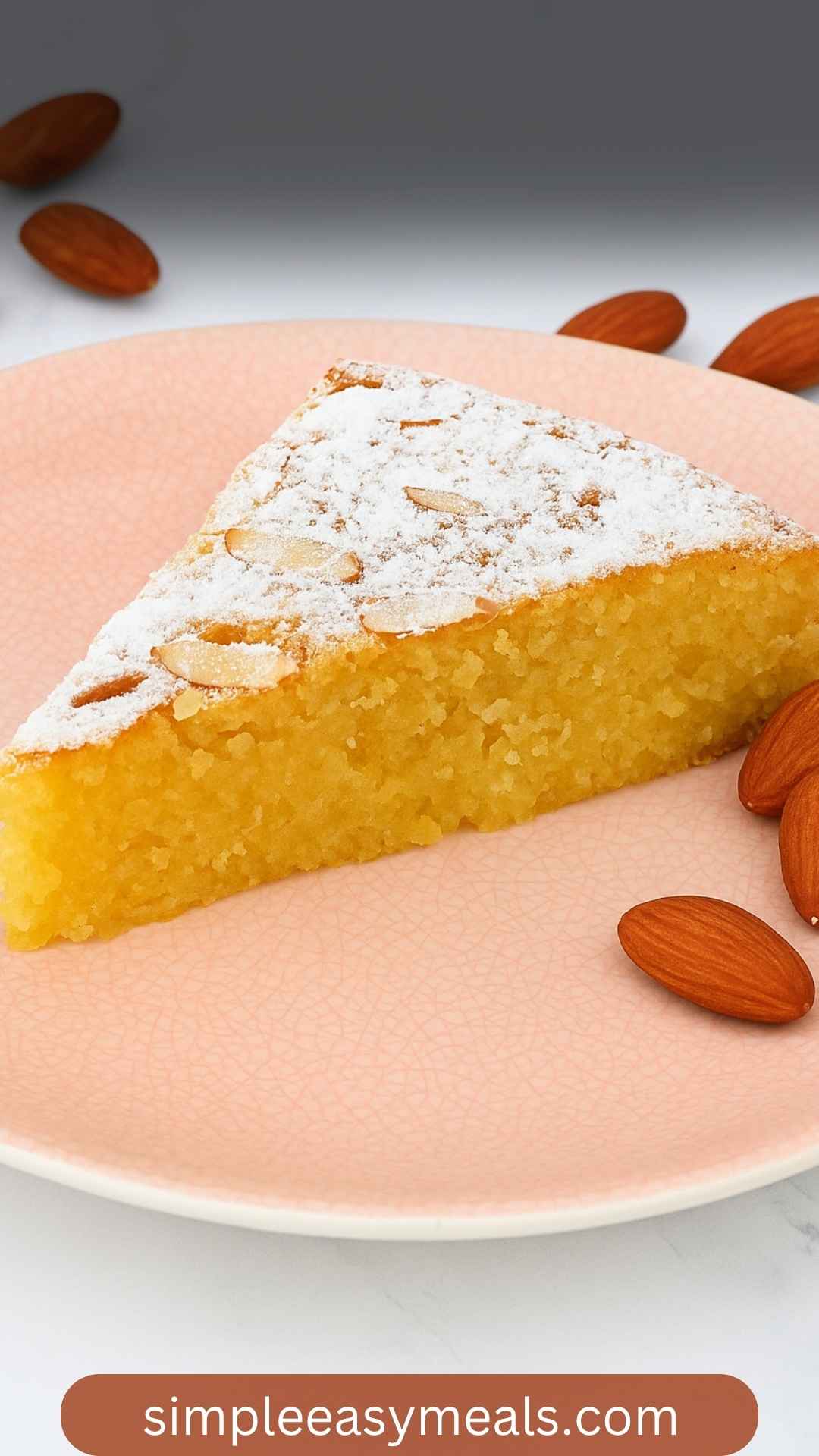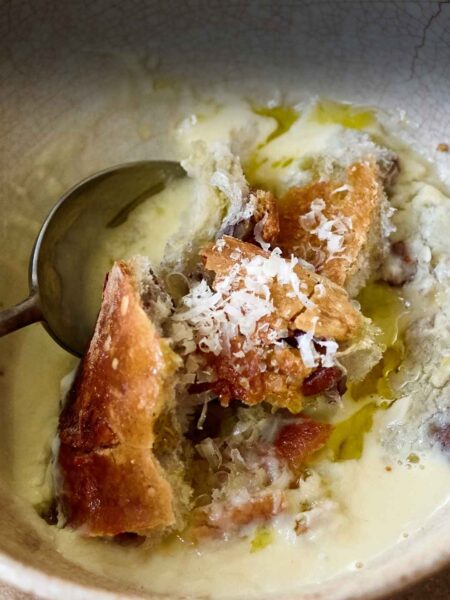Almond cake is a cherished dessert with a unique flavor profile that can elevate any gathering. If you’ve never tried pairing almond cake with fresh strawberries or perhaps a dollop of whipped cream, you’re in for a real treat.
Imagine the nutty essence of the cake mingling with the sweetness of ripe berries or the creamy texture of whipped cream—a match made in dessert heaven!

What Is Almond Cake?
Almond cake isn’t just any cake; it has roots in various cultures, especially in Italy and other regions where almonds are popular. This cake has a moist crumb with a delightful almond flavor that comes from using almond meal.
It’s versatile, as you can serve it plain, dusted with powdered sugar, or dressed up with frosting and fruit. It’s a cake that brings a bit of gourmet magic to your table.
Why You’ll Love This Almond Cake?
The charm of almond cake lies in its simplicity and depth of flavor. First off, it’s gluten-free and can easily cater to dietary needs without sacrificing taste. Its key ingredients—almond meal and eggs—create a rich texture that melts in your mouth.
One of my favorite aspects of this cake is how it transports you to a sunny Italian kitchen with every bite. An airy kitchen filled with laughter and the scent of baked goods wafting through the air.
When you share this cake with friends and family, you’ll find it quickly becomes a conversation starter, drawing everyone into discussions about favorite desserts, family recipes, and cooking adventures.
Did I mention it’s incredibly easy to prepare? This cake requires minimal effort while delivering maximum satisfaction.
Whether it’s a family gathering or a special occasion, it fits right in. The cake can stand proudly on any dessert table, accompanied by fruits or a light glaze, or simply enjoyed on its own.
The Ingredients You Will Need To Make Almond Cake
Creating this almond cake requires minimal ingredients, most of which you may already have in your pantry:
- 4 large eggs, at room temperature
- ⅔ cup caster sugar
- ½ cup melted unsalted European-style butter
- 2 cups finely ground almond meal
- ½ cup unsweetened shredded coconut flakes
- 2 teaspoons baking soda
- ¼ teaspoon sea salt
- 1½ teaspoons pure vanilla extract
- 1 teaspoon ground cinnamon
- 1 tablespoon orange zest
- ¼ cup slivered almonds
- 2 tablespoons powdered sugar, for dusting on top

Directions
Step 1: Preparing the Oven and Baking Pan
Preheat your oven to 350°F (175°C). This initial step is crucial for an even baking process. Grease a round cake pan or line it with parchment paper for easy release.
Step 2: Mixing the Wet Ingredients
In a large mixing bowl, whisk together the eggs and caster sugar until the mixture is light and fluffy.
This process introduces air into the batter, contributing to the cake’s overall texture. Add in the melted butter, vanilla extract, and orange zest. Mix until fully combined.
Step 3: Combining the Dry Ingredients
In another bowl, whisk together the almond meal, shredded coconut, baking soda, salt, and ground cinnamon.
This step ensures that the dry ingredients are evenly distributed, which is key to a uniform rise and flavor throughout the cake.
Step 4: Merging the Mixtures
Gradually fold the dry ingredients into the wet mixture. Use a spatula to gently combine them. You want to keep the mixture airy, so be cautious not to over-mix. Once combined, you’ll have a thick, delightful batter.
Step 5: Adding Slivered Almonds
Mix in the slivered almonds, reserving a few to sprinkle on top. This will give the cake a lovely crunch when it’s baked.
Step 6: Baking the Cake
Pour the batter into the prepared cake pan. Spread it evenly with a spatula, then sprinkle the remaining slivered almonds on top for a beautiful finish.
Bake in the preheated oven for 25-30 minutes or until a toothpick inserted into the center comes out clean.
Step 7: Cooling and Serving
Once baked, remove the cake from the oven and let it cool in the pan for about 10 minutes. Then carefully transfer it to a wire rack to cool completely. Dust with powdered sugar before serving.
Notes
- Room Temperature Eggs: Using eggs at room temperature helps them mix better and create a fluffier texture. If you forget to take them out in advance, place them in warm water for a few minutes.
- Almond Meal Quality: Not all almond meals are created equal. Choose a finely ground almond meal for a smoother cake texture.
- Butter Melting: Ensure your butter isn’t too hot when adding it to the eggs. It should be warm to the touch but not bubbling.
- Mixing Technique: When combining the dry and wet ingredients, use a gentle folding motion. This keeps the batter light and airy.
- Testing for Doneness: Every oven is different. Start checking your cake a few minutes early to avoid over-baking.
Storage Tips
Almond cake can be stored at room temperature for about 2-3 days in an airtight container. If you live in a particularly humid climate, refrigerating it will help it last longer—up to a week.
Before serving, let it come to room temperature for the best flavor and texture.
Serving Suggestions
- With Fresh Berries: Top the cake with a mix of strawberries, blueberries, and raspberries. The tartness complements the sweetness perfectly, creating a fresh contrast.
- Lightly Whipped Cream: Serve individual slices with a generous dollop of whipped cream. It adds a creamy texture that balances the cake’s density.
- Ice Cream: Pair your slice with vanilla or almond-flavored ice cream for an extra indulgent treat.
- Coffee or Tea: Enjoy a slice with a cup of strong coffee or herbal tea. The warm beverage enhances the flavors and transforms dessert into a delightful afternoon break.
- Chocolate Drizzle: Drizzle melted chocolate over the top before serving. The rich chocolate adds another layer of flavor, making it extra special.
What Other Substitutes Can I Use in Almond Cake?
If you’re looking to make adjustments, here are some great substitutes:
- Coconut Flour: Use half the amount of coconut flour as a replacement for almond meal. It has a different texture and absorbs more moisture, so adjust the liquid content accordingly.
- Sunflower Seed Meal: This works similarly to almond meal and is perfect for nut-free baking. It provides a similar texture without the allergy concerns.
- Nut Butters: You might add almond butter or cashew butter in place of some melted butter. This contributes flavor and moisture.
- Applesauce: Use unsweetened applesauce as a fat replacer in equal amounts. It will keep the cake moist and lower the calorie count.
- Vanilla Extract Alternatives: If you’re out of vanilla extract, consider using almond extract. It will amplify the nutty flavor of the cake!

Conclusion
Almond cake is a delightful dish that adds both character and flavor to any event, from casual afternoons at home to formal celebrations. Its simple ingredients deliver remarkable taste and texture that captures the heart of anyone who tries it.
Plus, with numerous pairing options and endless ways to customize it, you’re bound to find a version that matches your style.
So gather your ingredients, don your apron, and let’s get baking!
You’ll not only create a sumptuous dessert but also build memories that linger long after the last bite has been savored. Enjoy the process, share it with friends and family, and celebrate the joy of good food. Happy baking!
You’ll also like the following recipes!
Almond Cake Recipe – Simple Easy Meals
Almond cake is a cherished dessert with a unique flavor profile that can elevate any gathering. If you've never tried pairing almond cake with fresh strawberries or perhaps a dollop of whipped cream, you’re in for a real treat.

Ingredients
Instructions
Step 1: Preparing the Oven and Baking Pan
-
Preheat your oven to 350°F (175°C). This initial step is crucial for an even baking process. Grease a round cake pan or line it with parchment paper for easy release.
Step 2: Mixing the Wet Ingredients
-
In a large mixing bowl, whisk together the eggs and caster sugar until the mixture is light and fluffy.
This process introduces air into the batter, contributing to the cake's overall texture. Add in the melted butter, vanilla extract, and orange zest. Mix until fully combined.
Step 3: Combining the Dry Ingredients
-
In another bowl, whisk together the almond meal, shredded coconut, baking soda, salt, and ground cinnamon.
This step ensures that the dry ingredients are evenly distributed, which is key to a uniform rise and flavor throughout the cake.
Step 4: Merging the Mixtures
-
Gradually fold the dry ingredients into the wet mixture. Use a spatula to gently combine them. You want to keep the mixture airy, so be cautious not to over-mix. Once combined, you’ll have a thick, delightful batter.
Step 5: Adding Slivered Almonds
-
Mix in the slivered almonds, reserving a few to sprinkle on top. This will give the cake a lovely crunch when it’s baked.
Step 6: Baking the Cake
-
Pour the batter into the prepared cake pan. Spread it evenly with a spatula, then sprinkle the remaining slivered almonds on top for a beautiful finish.
Bake in the preheated oven for 25-30 minutes or until a toothpick inserted into the center comes out clean.
Step 7: Cooling and Serving
-
Once baked, remove the cake from the oven and let it cool in the pan for about 10 minutes. Then carefully transfer it to a wire rack to cool completely. Dust with powdered sugar before serving.
Nutrition Facts
Servings 12
- Amount Per Serving
- Calories 291kcal
- % Daily Value *
- Total Fat 24.6g38%
- Saturated Fat 5.9g30%
- Cholesterol 61mg21%
- Sodium 69mg3%
- Total Carbohydrate 12g4%
- Dietary Fiber 3g12%
- Sugars 6g
- Protein 11g22%
* Percent Daily Values are based on a 2,000 calorie diet. Your daily value may be higher or lower depending on your calorie needs.
Note
- Room Temperature Eggs: Using eggs at room temperature helps them mix better and create a fluffier texture. If you forget to take them out in advance, place them in warm water for a few minutes.
- Almond Meal Quality: Not all almond meals are created equal. Choose a finely ground almond meal for a smoother cake texture.
- Butter Melting: Ensure your butter isn’t too hot when adding it to the eggs. It should be warm to the touch but not bubbling.
- Mixing Technique: When combining the dry and wet ingredients, use a gentle folding motion. This keeps the batter light and airy.
- Testing for Doneness: Every oven is different. Start checking your cake a few minutes early to avoid over-baking.





